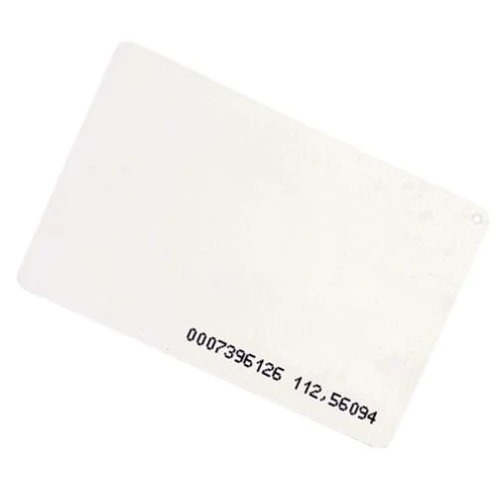RFID (Radio Frequency Identification) cards are advanced technology cards embedded with a small chip and antenna, enabling them to communicate wirelessly with RFID readers. Widely used across various industries, these cards streamline identification, access control, and asset tracking processes. Here’s an overview of RFID card types and their applications: Types of RFID Cards: Thick and Thin Cards: These refer to the physical dimensions of RFID cards. Thick cards are more durable and often used for access control, while thin cards are lightweight, ideal for ID badges and event passes. Proximity Cards: Proximity cards operate at a low frequency (125 kHz) and are commonly used in access control systems. They allow contactless entry and are widely adopted in corporate environments and security-sensitive areas. MIFARE Cards: Operating at 13.56 MHz, these high-frequency cards offer higher data storage and security options. MIFARE cards are used for public transportation, parking, and loyalty programs due to their versatility and secure data encryption. UHF Cards: Ultra-High Frequency (UHF) cards operate between 860-960 MHz, offering a read range up to 15 meters, ideal for asset tracking, supply chain management, and vehicle identification. RFID Tags: While similar to RFID cards, tags come in various forms (adhesive, ruggedized, etc.) and are versatile for tracking goods, inventory management, and industrial applications. Applications of RFID Cards: Manufacturing: Used for tracking equipment, managing inventory, and ensuring safety compliance. RFID cards improve efficiency in complex operations by providing real-time data. IT & Corporates: Used in access control systems, these cards allow seamless entry to secure zones and help in employee attendance tracking. RFID cards reduce unauthorized access and enhance security. Healthcare: Used for patient tracking, equipment management, and medication distribution. RFID cards streamline operations and reduce human error. Education: Used for library management, student attendance, and access control on campus. Incorporating RFID technology provides high reliability, security, and efficiency across these sectors.
Chat with us on WhatsApp
×
This is your website preview.
Currently it only shows your basic business info. Start adding relevant business details such as description, images and products or services to gain your customers attention by using Boost 360 android app / iOS App / web portal.
https://www.matrixsolutionstech.com/latest-update/rfid-radio-frequency-identification-cards-are-ad/92
RFID (Radio Frequency Identification) cards are ad...

2024-11-11T08:02:32
RFID (Radio Frequency Identification) cards are advanced technology cards embedded with a small chip and antenna, enabling them to communicate wirelessly with RFID readers. Widely used across various industries, these cards streamline identification, access control, and asset tracking processes. Here’s an overview of RFID card types and their applications: Types of RFID Cards: Thick and Thin Cards: These refer to the physical dimensions of RFID cards. Thick cards are more durable and often used for access control, while thin cards are lightweight, ideal for ID badges and event passes. Proximity Cards: Proximity cards operate at a low frequency (125 kHz) and are commonly used in access control systems. They allow contactless entry and are widely adopted in corporate environments and security-sensitive areas. MIFARE Cards: Operating at 13.56 MHz, these high-frequency cards offer higher data storage and security options. MIFARE cards are used for public transportation, parking, and loyalty programs due to their versatility and secure data encryption. UHF Cards: Ultra-High Frequency (UHF) cards operate between 860-960 MHz, offering a read range up to 15 meters, ideal for asset tracking, supply chain management, and vehicle identification. RFID Tags: While similar to RFID cards, tags come in various forms (adhesive, ruggedized, etc.) and are versatile for tracking goods, inventory management, and industrial applications. Applications of RFID Cards: Manufacturing: Used for tracking equipment, managing inventory, and ensuring safety compliance. RFID cards improve efficiency in complex operations by providing real-time data. IT & Corporates: Used in access control systems, these cards allow seamless entry to secure zones and help in employee attendance tracking. RFID cards reduce unauthorized access and enhance security. Healthcare: Used for patient tracking, equipment management, and medication distribution. RFID cards streamline operations and reduce human error. Education: Used for library management, student attendance, and access control on campus. Incorporating RFID technology provides high reliability, security, and efficiency across these sectors.
2024-11-11T08:02:32
Keywords
- 125 kHz
- 15 meters
- 13.56 MHz
- RFID Tags
- ID badges
- UHF Cards
- read range
- Thin Cards
- RFID Cards
- small chip
- 860-960 MHz
- Thick cards
- human error
- MIFARE Cards
- event passes
- RFID readers
- various forms
- low frequency
- seamless entry
- tracking goods
- real-time data
- Proximity Cards
- RFID technology
- RFID card types
- security options
- loyalty programs
- patient tracking
- safety compliance
- contactless entry
- complex operations
- student attendance
- various industries
- library management
- employee attendance
- physical dimensions
- unauthorized access
- higher data storage
- equipment management
- inventory management
- high-frequency cards
- public transportation
- vehicle identification
- corporate environments
- access control systems
- secure data encryption
- industrial applications
- medication distribution
- supply chain management
- security-sensitive areas
- asset tracking processes
- advanced technology cards
- Radio Frequency Identification
- Ultra-High Frequency (UHF) cards

Submit Your Enquiry